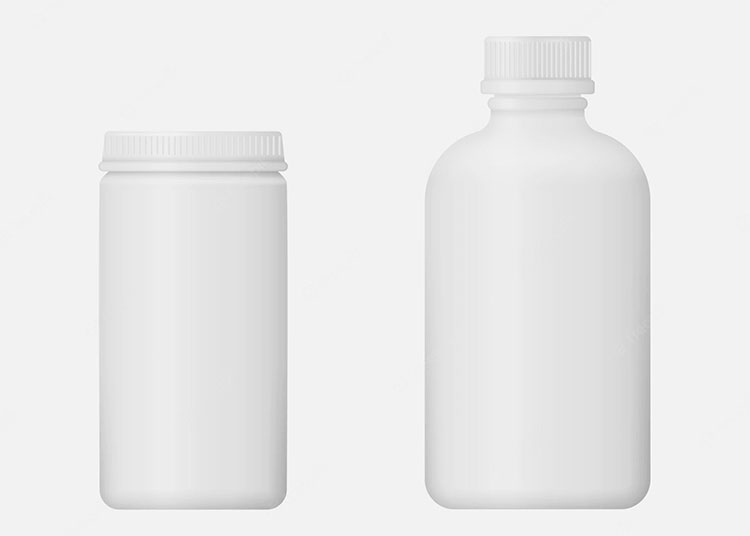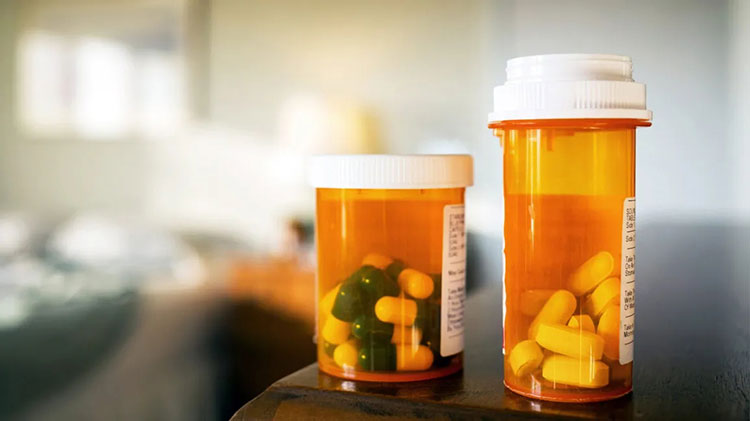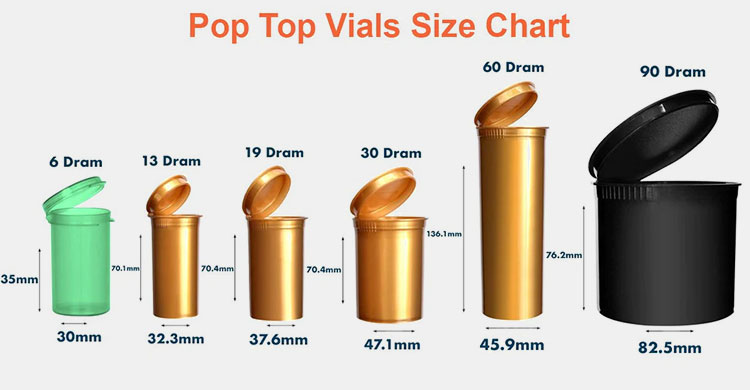Bottle Size Chart for Capsules&Pills
The development of science and technology has made pharmaceutical packaging show a diversified development trend. Common packaging forms of capsules and pills include blister packaging, bag packaging, plastic bottle packaging, etc. Among them, capsule and pill medicine bottles are a type of packaging that is used in relatively large amounts. Have you ever noticed which capsules or pills are packaged in bottles? And what are the differences between different size capsules & pill bottles?
This article will take you through the bottled forms of capsules and pills. Let’s take a look at the next questions and corresponding answers.
1. What Are the Capsule & Pill Bottles?

Capsule Bottles -photo credits: shutterstock
Capsules & Pill Bottles, also known as pill bottles, vitamin bottles, and prescription bottles, are commonly used in industries such as pharmaceutical and nutraceuticals, as well as personal care.

Pill Bottles -photo credits: awsinsurance
These plastic containers feature wide mouths, light-weight, and unbreakable bottles. Capsules & Pill Bottles are perfect for easy filling and dispensing pills, capsules, vitamins, nutritional supplements, and more.
The bottle cap is an important part of the bottle. Its function is mainly to isolate the influence of the external environment on the contents, and on the other hand, it also plays a certain decorative role.
There are 3 main types of Capsules and Pill Bottles from their caps.

Ordinary Cap Bottles
Ordinary Cap Bottle: Generally, drugs that do not have special requirements for bottle caps will choose ordinary screw caps. To ensure the bottle has a good seal, this type of bottle cap is sealed with an aluminum foil gasket.
Its function is mainly used to block the direct contact between the bottle mouth and the inside of the bottle cap, so as to prevent the bottle cap from being unable to completely block the external air.

Press-screw Cap Bottles
Press-screw Cap Bottle: This is a special kind of cap. It consists of an inner and outer double-layer structure. When opening, it is necessary to apply downward pressure while twisting the cap.
This opening method is difficult for children who are still in the developmental stage, so as to avoid the occurrence of accidental ingestion of medicines by children.

Moisture-proof Cap Bottles
Moisture-proof Cap Bottle: This is a new type of cap that combines desiccant and cap into one. Generally, the desiccant will be placed inside the bottle in the form of a bag. The moisture-proof cap uses the space at the top of the bottle cap to place the desiccant in the small medicine compartment on the top of the bottle cap.
It not only avoids direct contact between the medicine and the desiccant but also prevents children from accidentally eating the desiccant.
2. What Are the Main Colors of Capsules & Pill Bottles?
After learning about the types of capsule and pill bottles, you may be wondering why the same bottle has different colors. Why is this? The reasons are below.

Capsule Bottles with Different Colors -photo credits: shutterstock
Capsules & Pill Bottles are a common way of bottling pharmaceutical dosage forms in our lives. According to the different properties of drugs or the different needs of pharmaceutical factories, such packaging presents different colors, among which white, brown, and transparent are the most common ones.

White Capsule Bottles -photo credits: uline
White: Widely used color. Generally, medicines without special needs will choose white pill bottles. This is because white is a light color that reflects light. If it is dark, it will be exposed to sunlight.
After the drug absorbs light, it is easy to deteriorate. On the other hand, white also gives a particularly clean and elegant feel, which is perfect for pharmaceutical packaging.

Brown Capsule Bottles -photo credits: silverspurcorp
Brown: The brown capsules & pill bottle are the color masterbatch added to the processing raw material, which changes the original color. Some drugs are easily decomposed and deteriorated when exposed to light.
This color prevents exposure to visible light. It is mainly suitable for light-sensitive drugs.

Transparent Pill Bottles -photo credits: freepik
Transparency: This kind of capsule & pill bottle is mostly made of polyester raw material. The shape and color of the medicine can be observed through the transparent bottle body.
It is mainly suitable for the packaging of solid medicines such as candy tablets and liquid calcium. Transparent packaging of medicines of various colors can also improve the overall aesthetics of medicines.

Vitamin C Pill Bottles -photo credits: 3docean.net
These are the three common colors for capsules & pill bottles. Of course, in order to improve product differentiation, some companies will require bottle caps to be made in other colors, such as vitamin C-effervescent tablets.
3. What Are the Main Shapes and Benefits of Capsule & Pill Bottles?
For most of the capsule & pill bottles, it is not difficult to find that there are more rounds, followed by squares, so why are there two different shapes of capsule & pill bottle?

Capsule Bottles with Different Shapes -photo credits: freepik
The different shapes of different bottles have been poured into the designers’ efforts. Different capsules and pills will be packaged in different-shaped bottles.
- Round Capsule & Pill Bottles
These occupy a large proportion of pharmaceutical packaging, mainly due to the following benefits:

Cut Costs -photo credits: thundertix
Cost Saving: From a mathematical point of view, when the perimeter is fixed, the circular area is relatively large, and the nearly circular shape can save raw materials, which is the main reason for vigorously choosing round bottles.
Durable and Beautiful: From an aesthetic point of view, due to the habit of long-term development, the round shape is more in line with the aesthetics of most people.

Round Capsule Bottles -photo credits: vecteezy
The Process Is Simple: From the manufacturing point of view, whether it is glass or plastic, the round shape is relatively easy to process, and other shapes need to be remade, and it is difficult to guarantee the process.

Taking Capsules -photo credits: npr.org
Easy To Use: From a behavioral point of view, the round shape conforms to the characteristics of human mechanics and is easy to grasp.
Another capsule & pill bottle shape that occupies a certain proportion of the medicine bottle is a square shape, which is designed to be more grippy than a round shape but is slightly more difficult to manufacture.

Square Capsule Bottles -photo credits: sks-science
In order to distinguish themselves from similar products on the market, some pharmaceutical companies also choose square bottles to improve product recognition.
4. What Are the Characteristics of Capsules & Pill Bottles?
Capsule & pill bottle is a type of packaging that is used in large amount. It has the following three characteristics:

Transportation -photo credits: industrytoday
Easy to Transport: The processing raw materials of the capsule & pill bottles are mainly polymer materials such as polyethylene (PE), polypropylene (PP), and polyester (PET).
It is more convenient for long-distance transportation and reduces the economic loss caused by packaging broken during transportation.

Capsule Bottles with Various Colors -photo credits: livescience
Various Colors: The colors of this type of packaging are white, brown, transparent, etc., which are mainly determined according to the different characteristics of the tablets.
Capsules and pills without special requirements generally use white bottles. Nitroglycerin tablets, antihypertensive drugs, and other drugs that are easily decomposed by light should be used in brown bottles.

Warehouse -photo credits: kindpng
Space Saving: Compared with blister packaging, capsule & pill bottles have a larger capacity and can hold a larger number of drugs.
On the one hand, it can reduce the packaging cost, and on the other hand, it is also beneficial to save a certain warehouse space for pharmaceutical companies and reduce drug storage costs.

Capsule and Pill Bottles with Various Shapes -photo credits: goodrx
With the continuous improvement of processing technologies such as injection molding, injection blowing, extrusion blowing, and injection stretch blowing, the shapes and functions of capsule & pill bottles have become more diversified, and they have become the mainstream packaging forms of solid drugs such as capsules, pills, and tablets.
5. What Are the Standard Capsule & Pill Sizes?
Internationally, there are clear regulations on the size of capsules. Do you know what size standard capsules are available?

Capsule Sizes -photo credits: kcaps
Standard capsule sizes are named by numerical values. They are numbered: 000, 00, 0, 1, 2, 3, 4, and 5. These capsules are sized for other types of gelatin, HPMC, and amylopectin. Most capsule filler models are compatible with these standard sizes.
- Standard Capsule SizeChart
| Size | 000 | 00 | 0 | 1 | 2 | 3 | 4 | 5 |
| Outer Diameter(mm) | 9.91 | 8.53 | 7.65 | 6.91 | 6.35 | 5.82 | 5.31 | 4.91 |
| Outer Diameter(In.) | 0.39 | 0.34 | 0.30 | 0.27 | 0.25 | 0.23 | 0.21 | 0.19 |
| Height or Locked Length(mm) | 26.14 | 23.30 | 21.70 | 19.40 | 18.00 | 15.90 | 14.30 | 11.10 |
| Height or Locked Length(In.) | 1.03 | 0.92 | 0.85 | 0.76 | 0.71 | 0.63 | 0.56 | 0.44 |
| Actual Volume(ml) | 1.37 | 0.95 | 0.68 | 0.50 | 0.37 | 0.30 | 0.21 | 0.13 |
| Typical Fill Weights(mg)0.70
Powder Density |
960 | 665 | 475 | 350 | 260 | 210 | 145 | 90 |
It is the standard capsule size chart. Different capsules have different sizes.

Tablet Size
According to a 2016 US study, the average/median pill size ranges from around 15mm to 17mm in length. The size and shape of the tablets are not specified. But one thing is certain, The largest dimension of a tablet should not exceed 22 mm.
6. How Are the Bottle Sizes of the Capsule & Pill Defined?
Capsule & pill bottles are generally made of pet material, which is not easy to break, has good sealing performance, is moisture-proof, hygienic, and meets the special requirements of pharmaceutical packaging.

PET Capsule Bottles -photo credits: drugplastics
It can be directly used for pharmaceutical packaging without cleaning and drying. It is an excellent pharmaceutical packaging container and is widely used in the packaging of oral solid drugs (such as tablets, capsules, granules, etc.) and oral liquid drugs (such as syrups, tinctures, etc.).

Oral Solid Drugs -photo credits: fiercepharma
Capsules and pill bottles are large or small. The size of the bottle is determined by the manufacturer according to the consumer demand for the capsule. For example, in the process of taking a drug, if the demand for capsules is relatively large for the entire course of treatment, the manufacturer will choose a larger bottle to pack.
The bottle size of capsules and pills is defined in 3 ways.

Pill Bottles with Different Capacities -photo credits: healthline
Capacity: Due to the particularity of drug packaging and medication, from a few milliliters to about 1000 milliliters, most of the capsule & pill bottle shapes are round, and there are also square, oval, and other shapes.
Protection: In order to ensure that the medicine is not damp or deteriorated within the validity period, the medicinal plastic bottle should have good sealing and barrier properties, which can prevent the influence of light, heat, water vapor, oxygen, etc. on the medicine.

Drug Safety -photo credits: drugwatch
Safety: The inner wall of the bottle is in direct contact with the medicine. Bottle-making materials must meet the requirements of drug packaging to ensure the safety of drugs.
Through these three aspects, you can understand why the capsule or pill bottle is designed to be large or small.
7. What Are the Matching Bottle Sizes for Capsules& Pills?
How will capsules & pills fit into different size bottles? It depends on the size of your capsules & pills and the capacity of the bottle you are using. To help your understanding. We made the chart below.

Capsule Sizes -photo credits: unsplash
The leftmost column shows the capsule size. When you are considering any capsule & pill bottles, please pay attention to the capsule quantity and match it to the bottle size you want to buy.
| Capsule Size | Capsule Count | Bottle Size |
| 1 | 30 | 60cc |
| 1 | 60 | 100cc |
| 1 | 90 | 120cc |
| 0 | 30 | 100cc |
| 0 | 60 | 120cc |
| 0 | 90 | 175/180cc |
| 0 | 120 | 200cc |
| 0 | 180 | 300cc |
| 00 | 30 | 100cc |
| 00 | 60 | 180cc |
| 00 | 90 | 275/300cc |
| 00 | 120 | 400cc |
| 00 | 180 | 500cc |
| 000 | 30 | 120cc |
| 000 | 60 | 200cc |
| 000 | 90 | 300cc |
| 000 | 120 | 400cc |
| 000 | 180 | 500cc |

Matching Bottle Size Chart -photo credits: Pharmaprimarypackaging
With the matching bottle size chart, you can choose the right bottle size for your capsules and pills.
8. What Are the Capsule & Pill Size Max for Bottle Sizes?
The capsule and pill bottles include plastic and glass ones. And all these bottles filled with capsules and pills are called packer bottles. The glass capsule and pill bottles are UV-filtering ambers or striking cobalt blue. The plastic capsule and pill bottles are lightweight PET plastic in amber, blue, clear, dark amber, or green.

Packer Bottle Capacity -photo credits: berlinpackaging
The Packer Bottle Capacity Chart below will help you know the max capsules and pills for different sizes.
| Capsule Size | Maximum Quantity of Pills | Weight |
| 1 | 30 | 2 oz / 60 ml |
| 1 | 60 | 3.4 oz / 100ml |
| 1 | 90 | 4 oz / 120 ml |
| 1 | 120 | 5 oz / 150 ml |
| 0 | 30 | 3.4 oz / 100ml |
| 0 | 60 | 4 oz / 120 ml |
| 0 | 90 | 6 oz / 180 ml |
| 0 | 120 | 6.7 oz / 200 ml |
| 0 | 180 | 10 oz / 300 ml |
| 00 | 30 | 3.4 oz / 100ml |
| 00 | 60 | 6 oz / 180 ml |
| 00 | 90 | 10 oz / 300 ml |
| 00 | 120 | 13.5 oz 400 ml |
| 00 | 180 | 17 oz / 500 ml |
| 000 | 30 | 4 oz / 120 ml |
| 000 | 60 | 6.7 oz / 200 ml |
| 000 | 90 | 10 oz / 300 ml |
| 000 | 120 | 13.5 oz 400 ml |
| 000 | 180 | 17 oz / 500 ml |
Packer Bottle Capacity Chart
9. What Is the Bottle Size Chart for Capsules& Pills?
There are different bottle sizes for capsules and pills.
- Pill Bottle Dram Size

Pill Bottle Dram Size Chart -photo credits: Pharmalock
- Pop Top Pill Bottle Size Chart

Pop Top Pill Bottle Size Chart
- Suggested Capsule and Pill Weight for Each Bottle Size
| Bottle Size | Opening In Inches | Suggested Gram Weight |
| 50 cc | 11/16” | 9 gram |
| 75 cc | 11/16” | 9 gram |
| 120 cc | 11/14” | 12 gram |
| 150 cc | 11/14” | 12 gram |
| 190 cc | 11/14” | 12 gram |
| 290 cc | 11/12” | 16 gram |
| 400 cc | 11/12” | 16 gram |
| 500 cc | 11/12” | 9 gram |
Different bottle size selections are based on capsule and tablet size and total volume.
10. What Are the Basic Requirements for Capsule & Pill Bottles?
Capsule & pill bottle is a common form of medicine packaging in our life, which is mainly made of polyethylene, polypropylene, polyester, and other polymer materials.

Polyethylene -photo credits: fastradius
Drugs are related to the health and safety of your health, so drug packaging should also meet the following three basic requirements:
- Requirements For Using in Different Circulation Conditions
Capsules & pills in the circulation field may be affected by transportation and handling conditions, climate change, storage time, etc., so the capsule & pill bottles should adapt to these conditions.
For example, the packaging measures for capsule & pill bottles should be considered in areas with high humidity. If the capsule & pill bottles need to be exported, the climate of the exporting country should also be considered.

Humidity -photo credits: goblueox
- It Should Be AdaptedTo the Content
The main concern here is the compatibility of the capsules & pills with packaging materials. According to the physicochemical properties and dosage form characteristics of the contained capsules & pills, different measures are taken.
If capsules & pills are exposed to light, it is easy to deteriorate and the capsules & pills are easily oxidized in the a. So capsules & pills should be placed in a light-shielding container to ensure the stability of the medicine.

Light-shielding Capsule and Pill Bottles
- Meet the Standardization Requirements
Bottles that meet the standardization requirements are conducive to ensuring the quality of drugs, facilitating drug transportation, loading and unloading, storage, and facilitating identification and measurement.

Pill Bottle Label -photo credits: thriftyfun
The above are the three basic requirements that capsules & pill bottles must meet. In addition, the packaging of capsules & pill bottles should also take into account the requirements of external labels and bottle caps.
The labels of special management capsules & pills, nonprescription drugs, and external use drugs must be printed with prescribed signs.
11. What Are the Common Processing Technologies for Capsule and Tablet Bottles?
Capsules & pills are the mainstream dosage form in today’s medicines, with the characteristics of accurate dosage and easy portability. Capsules & pills are packaged in blister packs, and bottles, among which capsule & pill bottles are the most commonly used.
The commonly used processing techniques include the following:
- Injection Blowing Molding

Injection Blowing Molding -photo credits: petallmfg
Firstly, the injection machine injects the molten plastic into the injection mold to form the tube blank. The tube blank is formed on a hollow punch with micro-holes in the peripheral wall. The tube blank is then moved into a blow mold while it is still hot.
Then, the mold is closed, and compressed air is introduced into the pipe of the mandrel. The parison is inflated and attached to the cavity wall of the mold.
- Injection Molding

Injection Molding -photo credits: wikipedia
It refers to the process of making semi-finished parts of a certain shape from molten raw materials through operations such as pressurization, injection, cooling, and separation.
This process adopts automatic production. The product quality is stable. The size is accurate. The scope of application is wide, and there is no seam.
- Extrusion Blow Molding

Extrusion Blow Molding -photo credits:geminigroup.net
It is a one-shot molding process, which is different from injection blow molding. The most commonly used materials in this process are polyolefins such as Low-Density Polyethylene (LDPE), High-density polyethylene (HDPE), and Propene Polymer (PP).
- Injection Stretch Blow Molding

Injection Stretch Blow Molding -photo credits: robinsonpackaging
First, the blank is injected by the injection molding machine. The hot parison is then stretched longitudinally, and then compressed air is introduced to stretch it laterally.
A product with the same shape as the mold cavity is obtained. This process is generally used for tablet medicine bottles made of PET.
Conclusion
Through the above description of the size of the capsules & pills and the size of the bottles, you can have a certain understanding of this. By referring to this article, you can know the size of your capsules and tablets, and the number of capsules you need to fill, so as to choose the matching capsule bottle. Hope this article can bring you more inspiration. If you have anything else that you don’t understand or need to ask, you are welcome to consult.
Don't forget to share this post!
CONTACT US
Tell us your raw material and project budget to get quotations within 24 hours.
WhatsApp Us: +86 181 7101 8586
The Buyer's Guide

Tell us your material or budget, we'll reply you ASAP within 24 hours
